Construction and Zoning of Ecological Security Patterns in Yichang City
Abstract
1. Introduction
2. Materials and Methods
2.1. Overview of the Study Area
2.2. Data Source
2.3. Research Methods
2.3.1. Ecological Source Areas Identification
Identification of Ecological Sources Based on Morphological Spatial Patterns
Landscape Connectivity Analysis
2.3.2. Construction of Ecological Vulnerability
Selection of Resistance Factor
Weighting Method Combining Subjective and Objective Factors
Circuit Theory
2.3.3. Zoning Management of Ecological Security Patterns
Habitat Quality Assessment
Community Mining Method
3. Results and Analysis
3.1. Identification of Ecological Sources
3.2. Construction of Ecological Resistance Surface
3.3. Construction of Ecological Security Patterns
3.3.1. Construction of Ecological Corridors
3.3.2. Identification of Ecological Pinch Points
3.3.3. Identification of Ecological Obstacles
3.4. Ecological Security Pattern Zoning
3.4.1. Habitat Quality Assessment Results
3.4.2. Ecological Zoning Results
4. Discussion
4.1. Scientific Significance and Practical Value of Ecological Pinch Points
4.2. Innovations and Limitations of Community Partitioning Methodology
4.3. Potential Improvements for Ecological Resistance Surface Construction
4.4. Universality and Regional Adaptability of Management Strategies
4.5. Limitations and Future Directions
5. Conclusions
Author Contributions
Funding
Institutional Review Board Statement
Informed Consent Statement
Data Availability Statement
Conflicts of Interest
References
- Dong, X.; Wang, F.; Fu, M. Research Progress and Prospects for Constructing Ecological Security Pattern Based on Ecological Network. Ecol. Indic. 2024, 168, 112800. [Google Scholar] [CrossRef]
- Ying, L.X.; Kong, L.Q.; Xiao, Y.; Ouyang, Z. The Research Progress and Prospect of Ecological Security and Its Assessing Approaches. Acta Ecol. Sin. 2022, 42, 1679–1692. [Google Scholar] [CrossRef]
- Li, T.; Li, L.; Tang, M.F.; Deng, H. Heterogeneous Impacts of Human Activity Intensity on Regional Ecological Security Patterns: The Case of Southwest China. Land 2024, 13, 2172. [Google Scholar] [CrossRef]
- Hua, X. Review and the Outlook of Land Use Ecological Security Pattern. Acta Ecol. Sin. 2008, 28, 6305–6311. [Google Scholar]
- Yaxian, G.; Wei, L.; Gang, H.; Shuhang, Z. Evaluation of Industrial Ecological Security in Industrial Transformation Demonstration Area Based on Spatiotemporal Differentiation. Geomat. Nat. Hazards Risk 2022, 13, 1422–1440. [Google Scholar] [CrossRef]
- Li, C.; Wu, Y.; Gao, B.; Zheng, K.; Wu, Y.; Wang, M. Construction of Ecological Security Pattern of National Ecological Barriers for Ecosystem Health Maintenance. Ecol. Indic. 2023, 146, 109801. [Google Scholar] [CrossRef]
- Liu, J.; Chen, B.; Zhang, M.; Wan, D.; Liu, X. Construction and Optimization of Ecological Security Patterns in the Songnen Plain. Front. Environ. Sci. 2024, 12, 1302896. [Google Scholar] [CrossRef]
- Gong, D.; Huang, M.; Lin, H. Construction of an Ecological Security Pattern in Rapidly Urbanizing Areas Based on Ecosystem Sustainability, Stability, and Integrity. Remote Sens. 2023, 15, 5728. [Google Scholar] [CrossRef]
- Qian, W.; Zhao, Y.; Li, X. Construction of Ecological Security Pattern in Coastal Urban Areas: A Case Study in Qingdao, China. Ecol. Indic. 2023, 154, 110754. [Google Scholar] [CrossRef]
- Qiao, Q.; Zhen, Z.; Liu, L.; Luo, P. The Construction of Ecological Security Pattern under Rapid Urbanization in the Loess Plateau: A Case Study of Taiyuan City. Remote Sens. 2023, 15, 1523. [Google Scholar] [CrossRef]
- Wu, Z.L.; Yang, J.Y.; Xie, H.L. Construction, Optimization and Restoration of Ecological Security Pattern in the Southern Hilly and Mountainous Region of China: A Case Study in Ruijin City. Acta Ecol. Sin. 2022, 42, 3998–4010. [Google Scholar] [CrossRef]
- Yu, K. Security Patterns and Surface Model in Landscape Ecological Planning. Landsc. Urban Plan. 1996, 36, 1–17. [Google Scholar] [CrossRef]
- Yao, Z.; Jiang, C.; Zong-Cheng, C.; Shi-Yuan, Z.; Guo-Dong, Z. Construction of Ecological Security PatternBased on Ecological Sensitivity Assessmentin Jining City, China. Pol. J. Environ. Stud. 2022, 31, 5383–5404. [Google Scholar] [CrossRef] [PubMed]
- Wen, J.; Hou, K. Research on the Progress of Regional Ecological Security Evaluation and Optimization of Its Common Limitations. Ecol. Indic. 2021, 127, 107797. [Google Scholar] [CrossRef]
- Xue, F.; Yang, Y.; Hu, Y. Integrating Supply and Benefits of Ecosystem Services into Ecological Security Pattern: A Spatial Flow Perspective. Ecol. Indic. 2024, 166, 112455. [Google Scholar] [CrossRef]
- Lin, W.H.; Wen, Z.F.; Wu, S.J.; Bi, Y. Identification and Optimization of Ecological Security Pattern in the Chengdu-Chongqing Economic Zone. Acta Ecol. Sin. 2023, 43, 973–985. [Google Scholar] [CrossRef]
- Xu, X.; Wang, S.; Rong, W. Construction of Ecological Network in Suzhou Based on the PLUS and MSPA Models. Ecol. Indic. 2023, 154, 110740. [Google Scholar] [CrossRef]
- Li, M.; Zhang, Z.; Liu, X.; Hui, Y. Multi-Scenario Analysis of Land Space Based on PLUS and MSPA. Environ. Monit. Assess. 2023, 195, 817. [Google Scholar] [CrossRef]
- Xin, C.; Jian, P.; Yanxu, L.I.U.; Yang, Y.; Guicai, L.I. Constructing Ecological Security Patterns in Yunfu City Based on the Framework of Importance-Sensitivity-Connectivity. Geogr. Res. 2017, 36, 471–484. [Google Scholar]
- Feng, Z.H.U.; Hongwei, Z. “AHP+entropy Weight Method” Based CW-TOPSIS Model for Predicting Rockburst. China Saf. Sci. J. 2020, 27, 128. [Google Scholar] [CrossRef]
- McRae, B.H.; Dickson, B.G.; Keitt, T.H.; Shah, V.B. Using Circuit Theory to Model Connectivity in Ecology, Evolution, and Conservation. Ecology 2008, 89, 2712–2724. [Google Scholar] [CrossRef] [PubMed]
- Shah, V.B.; McRae, B. Circuitscape: A Tool for Landscape Ecology. In Proceedings of the 7th Python in Science Conference, Austin, Texas, 28–30 June 2008; pp. 62–65. [Google Scholar] [CrossRef]
- An, Y.; Liu, S.; Sun, Y.; Shi, F.; Beazley, R. Construction and Optimization of an Ecological Network Based on Morphological Spatial Pattern Analysis and Circuit Theory. Landsc. Ecol. 2021, 36, 2059–2076. [Google Scholar] [CrossRef]
- Yu, H.; Gu, X.; Liu, G.; Fan, X.; Zhao, Q.; Zhang, Q. Construction of Regional Ecological Security Patterns Based on Multi-Criteria Decision Making and Circuit Theory. Remote Sens. 2022, 14, 527. [Google Scholar] [CrossRef]
- Liu, H.; Tang, D. Ecological Zoning and Ecosystem Management Based on Landscape Ecological Risk and Ecosystem Services: A Case Study in the Wuling Mountain Area. Ecol. Indic. 2024, 166, 112421. [Google Scholar] [CrossRef]
- Jiang, Z.; Gan, X.; Liu, J.; Bi, X.; Kang, A.; Zhou, B. Landscape Ecological Risk Assessment and Zoning Control Based on Ecosystem Service Value: Taking Sichuan Province as an Example. Appl. Sci. 2023, 13, 12103. [Google Scholar] [CrossRef]
- Wang, X.; Zhao, X.; Xu, Y.; Ran, Y.; Ye, X.; Zhou, Y.; Wu, B.; Chu, B. Quantifying the Supply-Demand Relationship of Ecosystem Services to Identify Ecological Management Zoning: A Case Study in Mountainous Areas of Northwest Yunnan, China. Heliyon 2024, 10, e32006. [Google Scholar] [CrossRef] [PubMed]
- Shi, Q.; Lu, J.; Han, J. Studying the Spatiotemporal Variations of the Ecological Network and Carbon Utilization Efficiency in Southeast Tibet Based on Complex Network Theory. Ecol. Indic. 2024, 166, 112521. [Google Scholar] [CrossRef]
- Song, S.; Xu, D.; Hu, S.; Shi, M. Ecological Network Optimization in Urban Central District Based on Complex Network Theory: A Case Study with the Urban Central District of Harbin. Int. J. Environ. Res. Public. Health 2021, 18, 1427. [Google Scholar] [CrossRef]
- Zhang, W. Improving Commuting Zones Using the Louvain Community Detection Algorithm. Econ. Lett. 2022, 219, 110827. [Google Scholar] [CrossRef]
- Shifaw, E.; Sha, J.; Li, X.; Bao, Z.; Ji, J.; Huang, J.; Kassaye, A.Y.; Hao, Z. Spatiotemporal Dynamics of Ecological Security Pattern Based on an Optimized Assessment Framework and Circuit Theory: A Case of Fuzhou City, China. Hum. Ecol. Risk Assess. Int. J. 2024, 30, 352–377. [Google Scholar] [CrossRef]
- Wang, Y.; Qu, Z.; Zhong, Q.; Zhang, Q.; Zhang, L.; Zhang, R.; Yi, Y.; Zhang, G.; Li, X.; Liu, J. Delimitation of Ecological Corridors in a Highly Urbanizing Region Based on Circuit Theory and MSPA. Ecol. Indic. 2022, 142, 109258. [Google Scholar] [CrossRef]
- Gao, C.; Pan, H.; Wang, M.; Zhang, T.; He, Y.; Cheng, J.; Yao, C. Identifying Priority Areas for Ecological Conservation and Restoration Based on Circuit Theory and Dynamic Weighted Complex Network: A Case Study of the Sichuan Basin. Ecol. Indic. 2023, 155, 111064. [Google Scholar] [CrossRef]
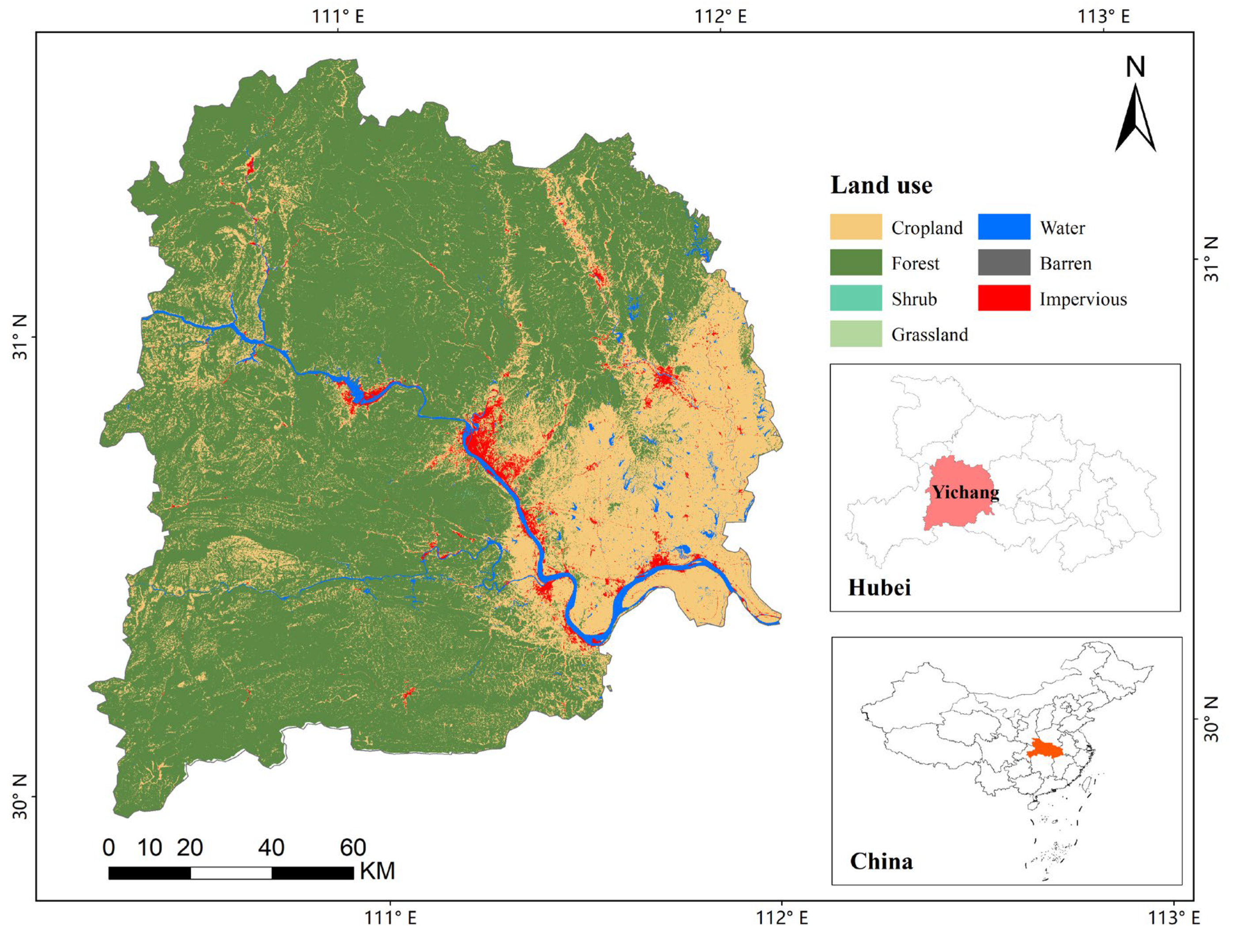

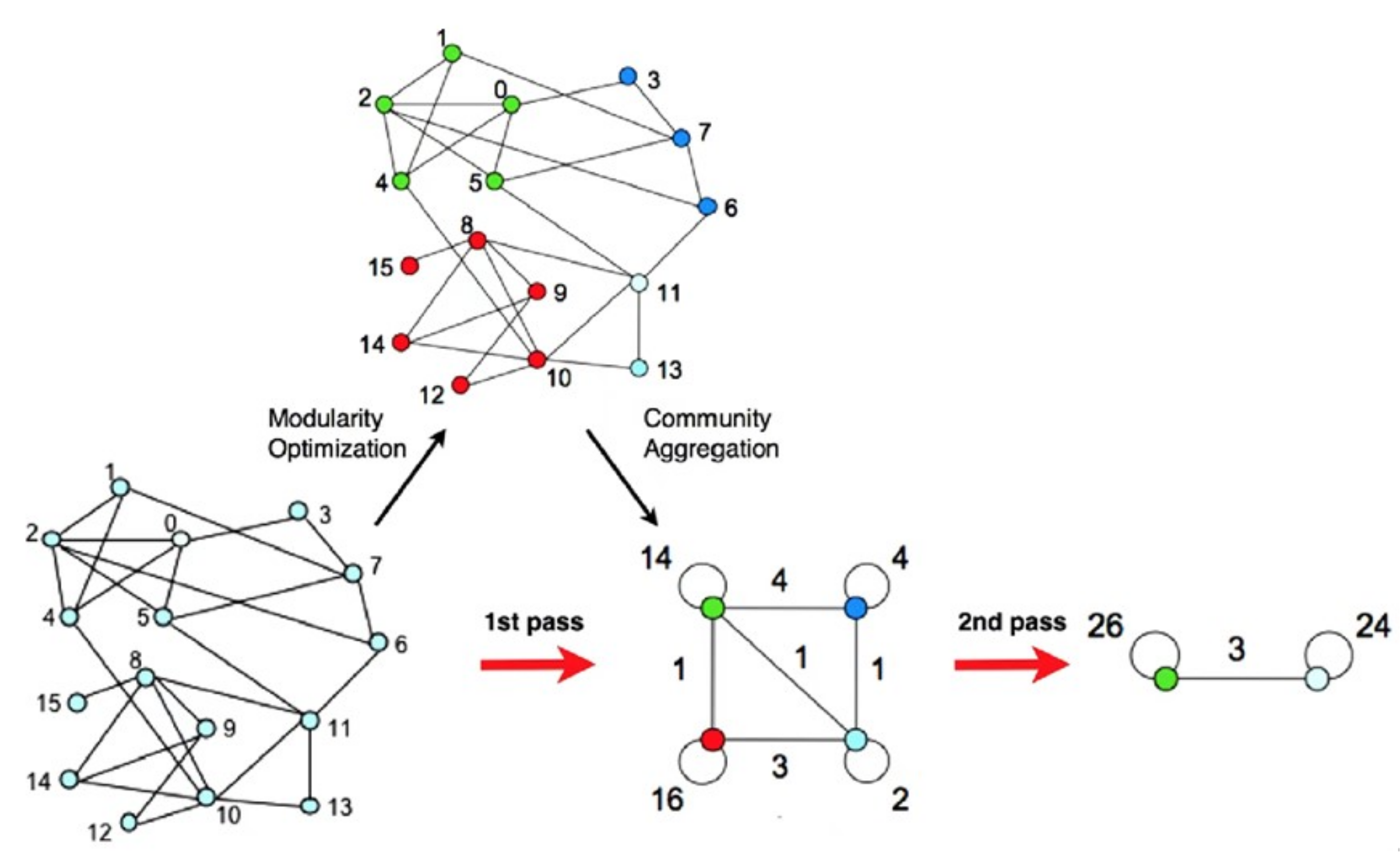

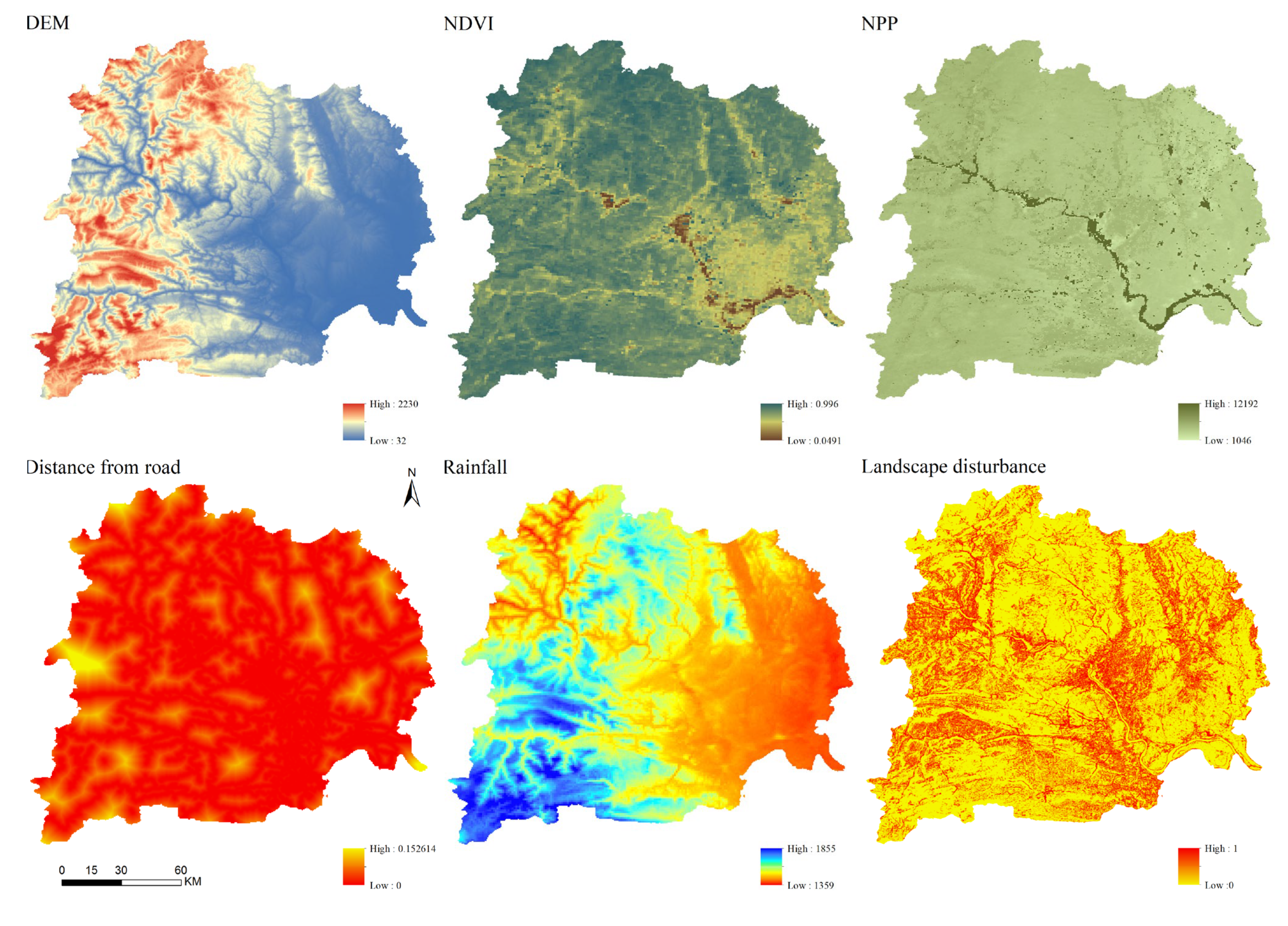


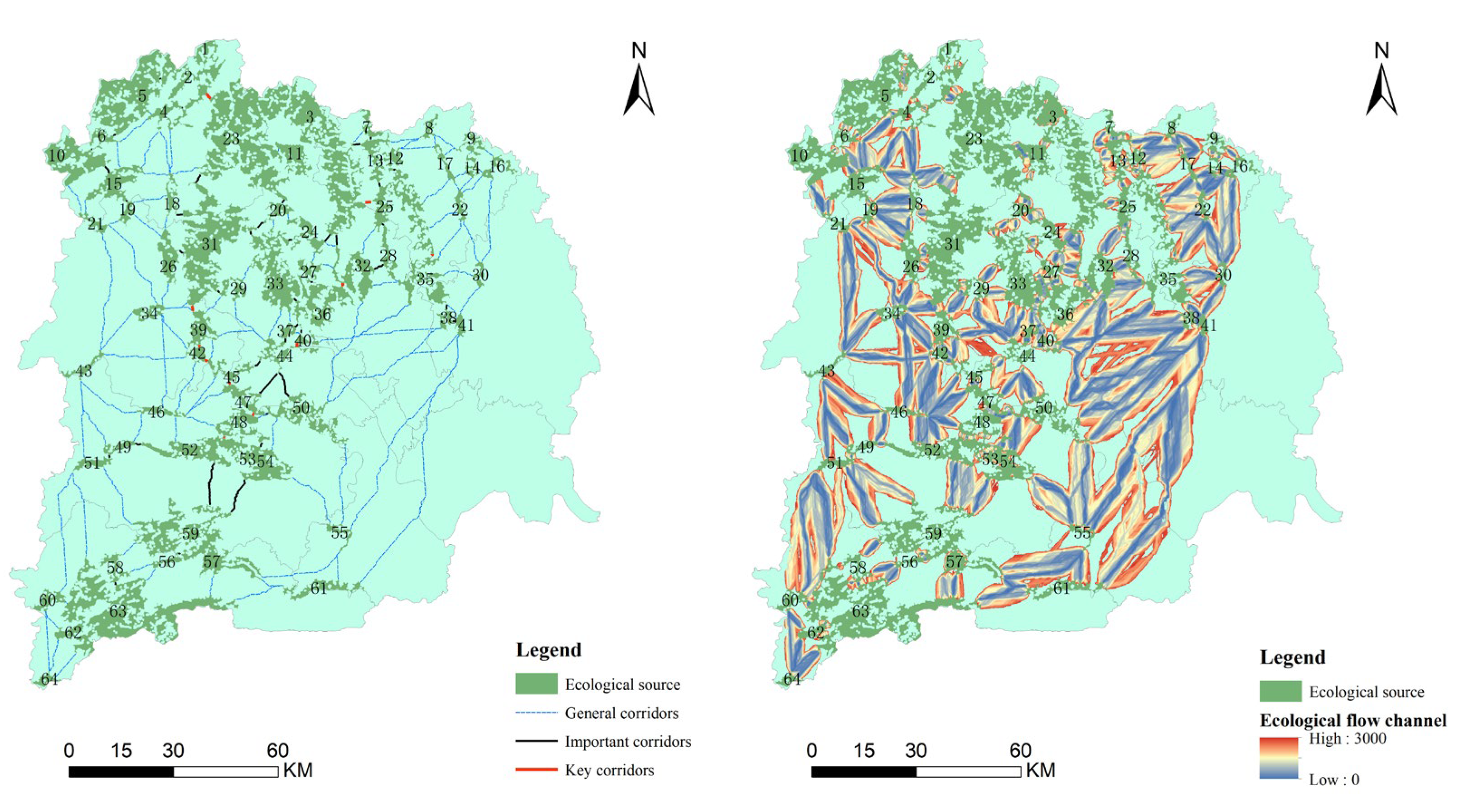
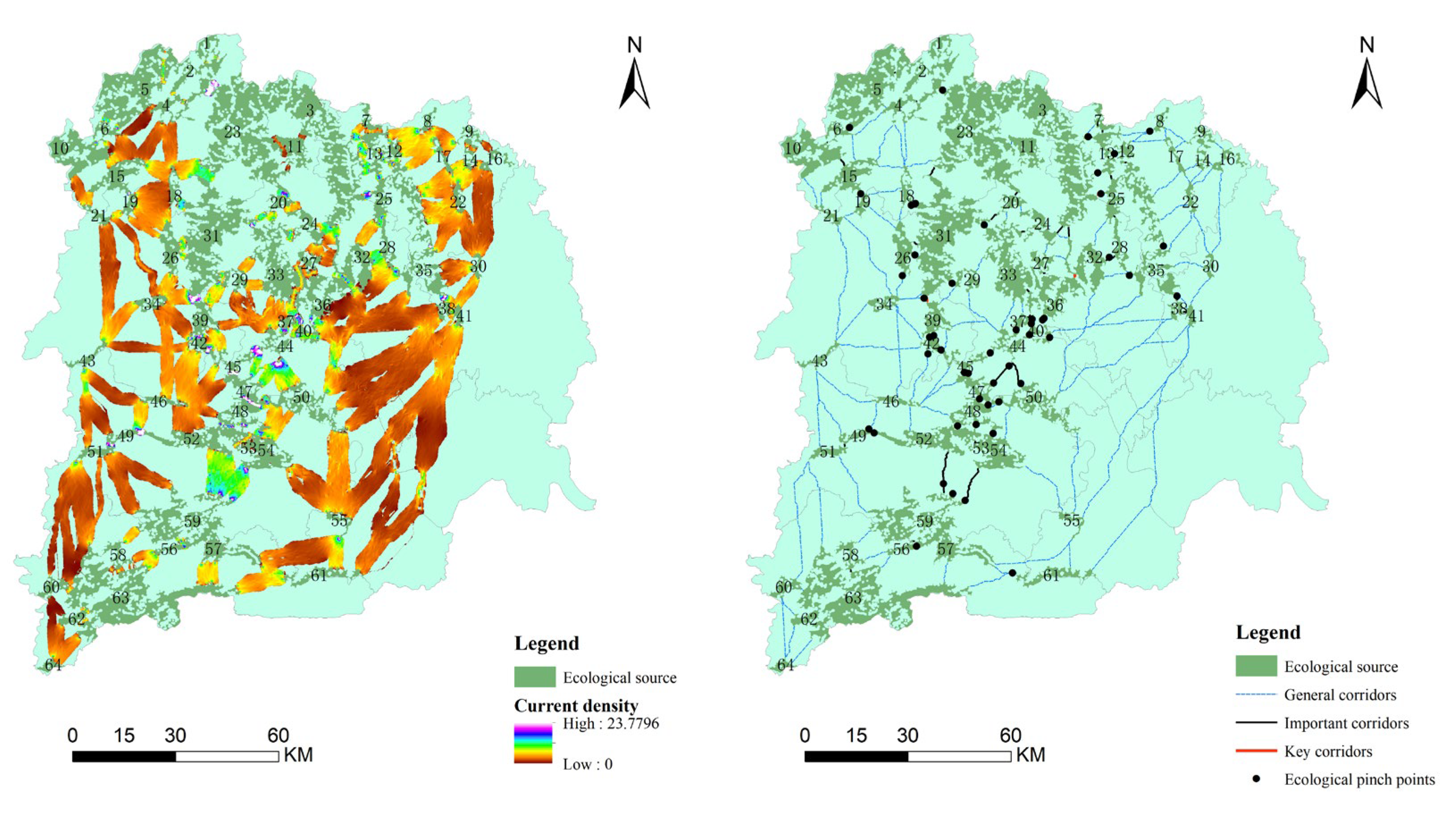
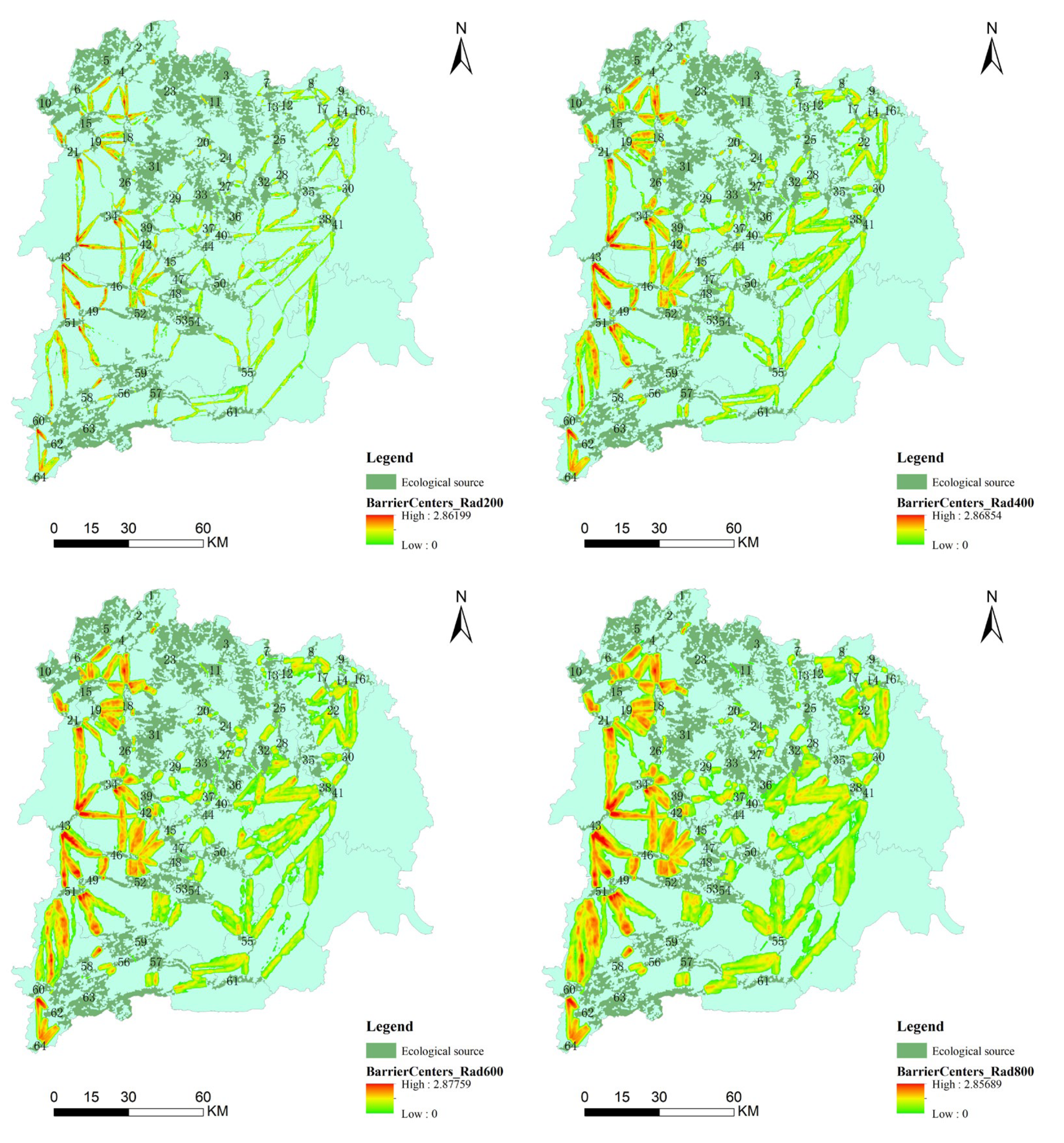

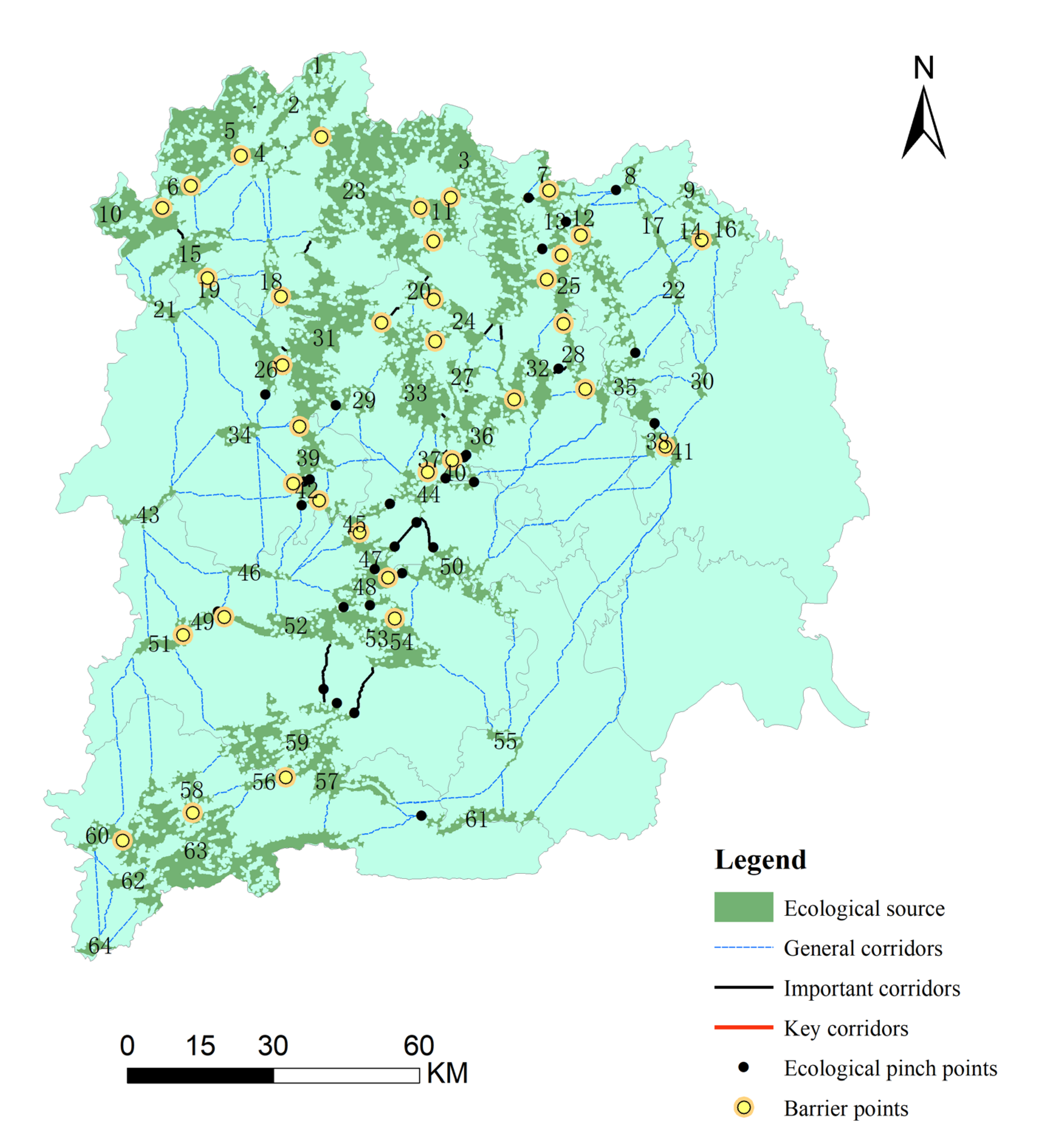
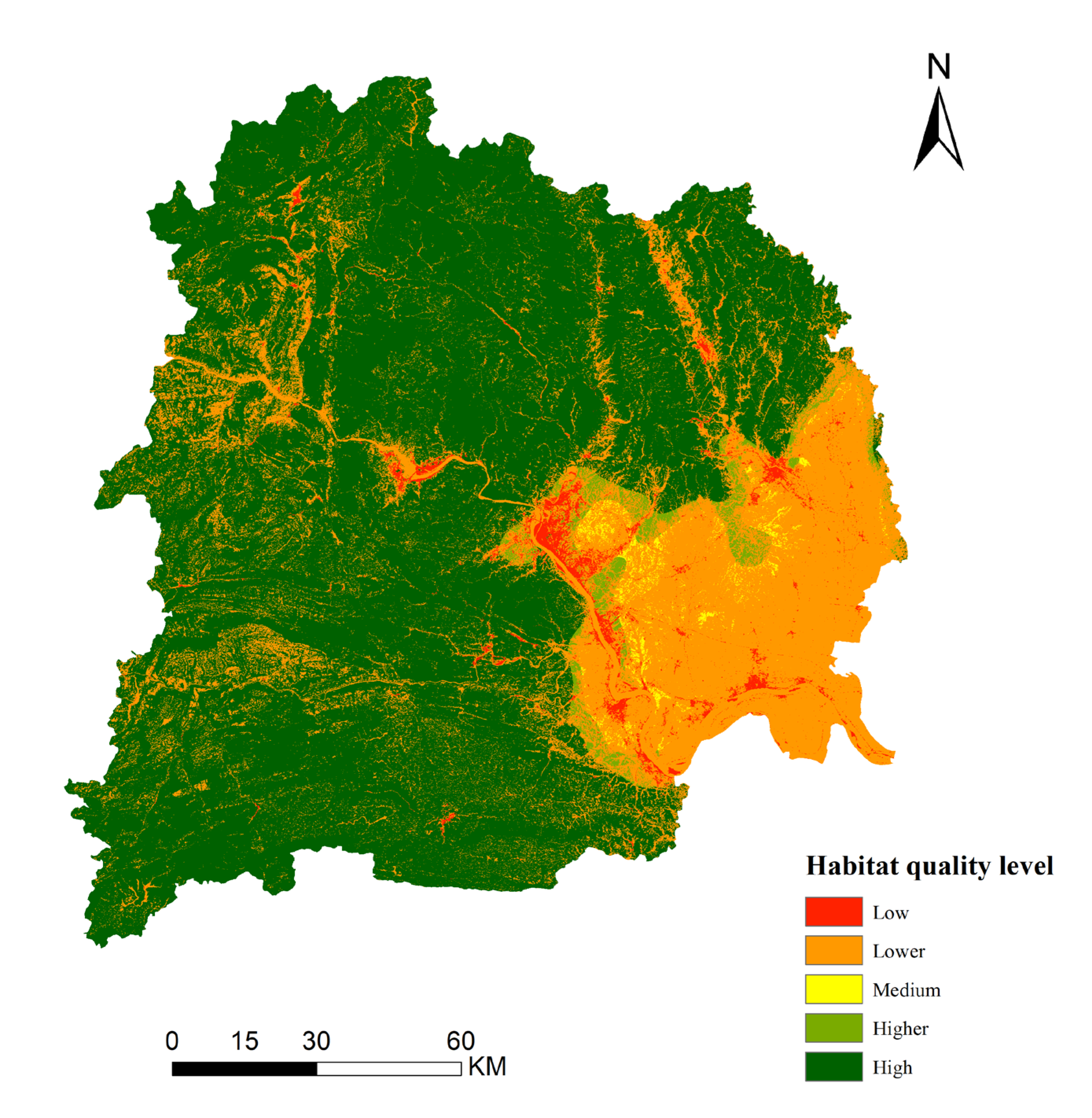

| Landscape Type | Ecological Significance |
|---|---|
| Core | A nature reserve, wildlife habitat, or an important core part of an ecosystem. |
| Islet | Often leads to habitat fragmentation and loss of biodiversity. |
| Perforation | It is the boundary area between different vegetation types, land-use types, or ecosystem types. |
| Edge | It has unique habitat characteristics and also faces influences and pressures from different habitats. |
| Loop | Connected to the core area, the presence of pores may affect biological migration and gene flow. |
| Bridge | Providing pathways for species migration helps maintain biodiversity and ecosystem integrity. |
| Branch | It often affects biological migration and landscape connectivity, which can have important impacts on ecosystems. |
| Threat Factors | Maximum Impact Distance | Weight | Recession Type |
|---|---|---|---|
| Construction land | 10 | 1 | Index |
| Arable land | 6 | 0.6 | Linear |
| Unused land | 4 | 0.4 | Linear |
| Land Type | Habitat Suitability | Threat Factors | ||
|---|---|---|---|---|
| Construction Land | Arable Land | Unused Land | ||
| Arable land | 0.3 | 0.8 | 0 | 0.4 |
| Woodland | 1 | 0.8 | 0.6 | 0.2 |
| Grassland | 1 | 0.7 | 0.5 | 0.6 |
| Waters | 0.9 | 0.7 | 0.4 | 0.4 |
| Unused land | 0.6 | 0.6 | 0.4 | 0 |
| Construction land | 0 | 0 | 0 | 0 |
| Distance and Score | Feature | General Corridor | Important Corridors | Key Corridors |
|---|---|---|---|---|
| Number of corridors | 104 | 42 | 11 | |
| Euclidean distance (m) | Mean | 11,394.56 | 1815.31 | 865.82 |
| Maximum | 75,721 | 11,141 | 1703 | |
| Minimum | 50 | 117 | 226 | |
| CWD (m) | Mean | 26,397.79 | 4262.17 | 2163.63 |
| Maximum | 141,896.36 | 25,591.84 | 4884.06 | |
| Minimum | 89.55 | 930.27 | 986.59 | |
| LCPL (m) | Mean | 12,451.35 | 2012.62 | 972.82 |
| Maximum | 82,896 | 12,607 | 1826 | |
| Minimum | 50 | 362 | 362 | |
| Flow centrality score | Natural breakpoint method | 10.84–98.57 | 98.57–217.11 | 217.11–421.85 |
| Community | Source Number | Total Source Area | Total Area of the Community | Mean Habitat Quality | Ecological Safety Level |
|---|---|---|---|---|---|
| 1 | 1, 2, 4, 5, 18, 6, 15, 10, 21, 19, 26 | 548.85 | 2806.60 | 0.89 | Higher |
| 2 | 23, 3, 7, 13, 8, 9, 12, 17, 14, 16, 11, 25, 22, 30, 35, 32, 28 | 1001.04 | 4187.91 | 0.8 4 | High |
| 3 | 31, 20, 24, 33, 27, 36, 29, 44, 37, 40 | 572.66 | 2257.90 | 0.85 | Medium |
| 4 | 34, 43, 39, 42, 46, 45, 49, 47 | 166.65 | 2300.73 | 0.8 7 | Lower |
| 5 | 41, 50, 38, 55, 61, 51, 48, 52, 54, 59, 60, 63, 53, 56, 58, 57, 62, 64 | 950.31 | 9646.96 | 0.73 | Low |
Disclaimer/Publisher’s Note: The statements, opinions and data contained in all publications are solely those of the individual author(s) and contributor(s) and not of MDPI and/or the editor(s). MDPI and/or the editor(s) disclaim responsibility for any injury to people or property resulting from any ideas, methods, instructions or products referred to in the content. |
© 2025 by the authors. Licensee MDPI, Basel, Switzerland. This article is an open access article distributed under the terms and conditions of the Creative Commons Attribution (CC BY) license (https://creativecommons.org/licenses/by/4.0/).
Share and Cite
Zhang, Q.; Sun, Y.; Tang, D.; Cheng, H.; Tu, Y. Construction and Zoning of Ecological Security Patterns in Yichang City. Sustainability 2025, 17, 2354. https://doi.org/10.3390/su17062354
Zhang Q, Sun Y, Tang D, Cheng H, Tu Y. Construction and Zoning of Ecological Security Patterns in Yichang City. Sustainability. 2025; 17(6):2354. https://doi.org/10.3390/su17062354
Chicago/Turabian StyleZhang, Qi, Yi Sun, Diwei Tang, Hu Cheng, and Yi Tu. 2025. "Construction and Zoning of Ecological Security Patterns in Yichang City" Sustainability 17, no. 6: 2354. https://doi.org/10.3390/su17062354
APA StyleZhang, Q., Sun, Y., Tang, D., Cheng, H., & Tu, Y. (2025). Construction and Zoning of Ecological Security Patterns in Yichang City. Sustainability, 17(6), 2354. https://doi.org/10.3390/su17062354





